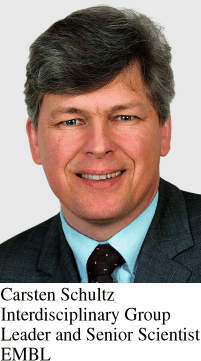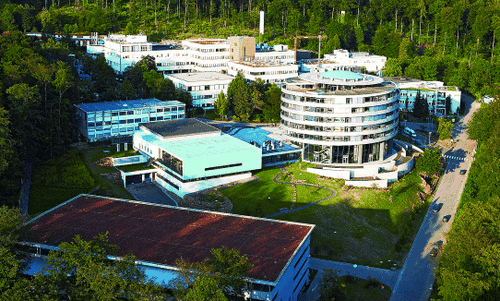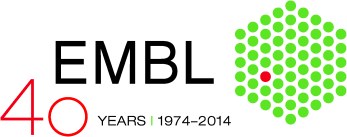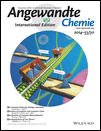Editorial: The European Molecular Biology Laboratory (EMBL)—Its Anniversary and Its Chemistry
The European Molecular Biology Laboratory (EMBL) is turning 40 this year. Scientists with the tremendous foresight that the field of molecular biology would explode founded the European Molecular Biology Organisation (EMBO) in 1964, and it celebrates its 50th birthday this year. The EMBL followed in 1974. While EMBO serves as an academy, a publisher, a funding agency for fellows, courses, and conferences, and an organizational hub in its field of research, the EMBL was established as an intergovernmental research institution following the example of CERN. It is currently funded by 21 member states and two associated nations (Australia and Argentina), with the Slovak Republic preparing to join.1



The EMBL Concept
The idea was and is to provide high-end technology to the European scientific community and the respective training in the molecular sciences that is not commonly available at universities and research institutions throughout Europe. This includes the latest in electron and light microscopy as well as in crystallography through the EMBL facilities in Hamburg, Grenoble, and Heidelberg. The EMBL also hosts the largest European bioinformatics center at the European Bioinformatics Institute (EBI) in Hinxton, UK, and a large mouse facility in Monterotondo near Rome. Scientifically, EMBL developed into the European flagship laboratory in molecular biology, frequently ranking among the institutions with the highest output in papers and highest number of citations worldwide. Its undisputed success is largely based on a few organizational features that helped to install a unique community of scientists and staff with no noticeable hierarchy.
From the mid-1980s onwards, contracts were limited to nine years for most lab members including scientists, administrators, and technicians. The goal is to give the most talented young scientists the resources to become world-leading in their specialty within this timeframe and to subsequently send them out to fertilize the institutions and universities in Europe. The lab maintains an unusually collaborative environment, partly by limiting the space each group is allowed to occupy and partly by the introduction of core facilities that frees young group leaders from the need of applying for large instrumentation that might take years until it is running. The nontenure system also ensures a fabulous flexibility with respect to adding new research areas. Indeed, in the past, we even saw entire research units being eliminated or reshaped and research directions appearing shortly after a new field has sprung up.
Chemistry at EMBL
Chemistry as a field at EMBL is one of these examples. Initially considered an essential asset for providing protein chemistry for crystallography, surface chemistry for making arrays and state-of-the-art synthesis for oligonucleotides, especially after the polymerase chain reaction (PCR) entered the labs, most of these “services” were taken over by commercial suppliers in the mid-1990s and the chemistry labs at EMBL fell silent. By that time though, one analytical aspect of chemistry became a hallmark of technology development at EMBL: the use of mass spectrometry for protein sequencing, which formed the basis of proteomics. The key papers published by EMBL’s Matthias Mann, Matthias Wilm, Andrej Shevchenko, and others in Analytical Chemistry in 1996 belong to the most frequently cited chemistry papers in that decade.
Chemistry as a discipline at EMBL was revived when chemical genetics became popular and some areas of biology started to change from a cell-batch- to a single-cell-based science. Fostered by the foresight of EMBL’s leadership, as well as on the suggestion of EMBL’s International Scientific Advisory Board, several chemistry groups were installed from 2001 to 2008, two of which perform preparative organic chemistry (Maja Köhn and our group), one that is more focused on biophysical chemistry (Edward Lemke), and two teams at the EMBL–EBI who specialize in cheminformatics. Importantly, the three experimental groups are distributed between three different units. This ensures maximal exposure of the chemists to the current biology in the laboratory and provides the biologists with information on the latest developments in chemistry. The decision to have chemistry groups with individual research programs made it necessary to install a chemical biology core facility that holds small-molecule libraries and robotic equipment, and provides assay development. In collaboration with and cofinanced by the University of Heidelberg and the German Cancer Research Center (DKFZ) in Heidelberg, the core facility has helped a number of research groups to find interesting small molecules and this has led to several start-up companies. Currently, the three institutions are installing a medicinal chemistry unit with new chemistry lab space, which will help to develop hits from the core facility’s screens into lead compounds.
How Much of a Biologist Should a Chemist Be?
In the meantime, the three chemistry research groups at EMBL have focused on providing new synthetic methods that are directly applicable to biological problems. In fact, many of the research projects evolved because there are pressing biological problems that cannot be solved without the help of innovative tools from the chemistry lab. At EMBL, we believe that this crossover is most likely to be successful if the chemists are so deeply involved in the biology that they answer their own biological questions. Obviously, this requires that the chemists need to become biologists to a certain extent.
As a part of basic research in biology is moving to smaller and smaller scales, it gets closer to the molecular level. The need to address questions on this scale makes it natural that scientists with a good understanding of molecular details become involved. By definition, these have to be chemists and traditionally, a large number of structural biologists come with a chemistry degree. However, the current challenges are different. As we start observing single molecules moving in a living cell or molecular machines in action, the understanding of cells and organisms requires a new three-dimensional perception that takes into account changes over time. This will help solve biological problems, and chemistry and chemistry-based methods will be crucial to permit a targeted manipulation while making highly sophisticated observations.
The Cell is the Test Tube
We have slowly learned that many biological processes in cells are much faster and more intertwined than we can simulate in a test tube and hence, it is necessary that the intact cell is our test tube. Since molecules must access the cells, we need an understanding of how to enable them to cross membranes, how they are metabolized, and how they distribute inside cells. This requires new noninvasive molecular techniques for labeling with dyes to count molecules, new reporters to quantitatively measure enzyme activities, and small molecules to precisely interfere with the complex biological system with high spatial and temporal control. If this idea is spun further, it might become interesting to simplify the system more towards a biochemical setup by removing cell parts that are not contributing to the observed phenomenon, while keeping the catalytic environment of a cell intact. In its final consequence, the outcome could be what chemists and biologists might imagine as “synthetic biology”. The term “synthetic” could then stand for the bridge between the building of molecules and the building of a cell or at least part of it. I acknowledge that some colleagues might have a totally different idea of what “synthetic biology” means.
Both synthetic biology and cell biology require a chemistry that is suitable for being performed inside living cells. In this respect, the field is still in its infancy but with new bioorthogonal reactions, such as “click” chemistry, being established every year, we will soon see that we will be able to produce effective modulators and reporters inside intact cells. Here, the imagination on one hand and to a significant extent the knowledge of chemistries that have been half-forgotten is what chemists will provide to insert the chemistry component into intact cells. Again, the cell is the test tube—even for chemical reactions.
In summary, it is conceivable that future generations of chemists will increasingly contribute to solving complex biological problems. For many subjects in the life sciences, chemistry is already essential today. The more that chemists are willing to look into biological questions, the closer we get to true interdisciplinarity. An institute for basic-science research in biology such as EMBL is a fantastic host for such projects and indeed for chemists.





